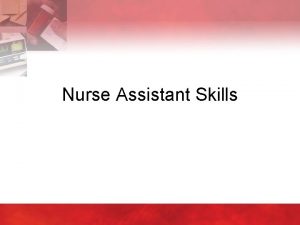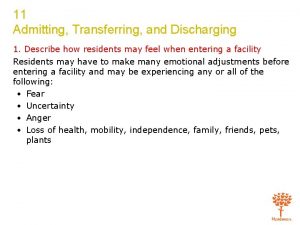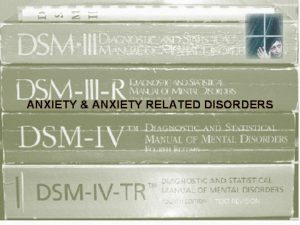Admitting Transferring and Discharging Patients Admission Anxiety Admission












- Slides: 12

Admitting, Transferring, and Discharging Patients

Admission Anxiety… Admission cause anxiety and fear Transferring from one room to the next is an example… the patient has to adjust to the new environment

Health Care Workers It is very important that the a health care worker makes a good first impression and makes the patient feel “at home” Some Examples… Being courteous, supportive, kind, and giving clear instructions on how to follow procedures

Health Care Workers… Do not rush when admitting, transferring, or discharging a patient. Allow the individual to ask questions (if you do not know the answer ask a supervisor. )

Admission, Transfer, or Discharge Forms… Facilities have a specific form for each form Forms list the procedures that must be performed and will vary slightly from facility to facility Information must be complete and accurate

If patient does not know answer to a question, a relative of the person responsible for patient may provide information. Questions regarding medications or allergies are answered by the nurse

Admitting… Certain procedures have to be followed… Vital signs, height and weight measurements, and collection of a routine urine specimen Use good technique while performing these procedures

List patient’s possessions… clothing, valuables, and personal items Family members may take clothing items home List must be checked by both health care worker and patient At the time of transfer or discharge, list must be checked to make sure that patient has all belongings

If family does not take clothing home, it should be put in safe place Money is counted, recorded, and kept

Equipment… Patient and Faculty should be oriented with instructions on how to operate equipment such as How to operate the call signal, bed controls, television remote, and other equipment provided Also visiting hours, location of lounges, smoking regulations and other services should be explained

Transfers… Done for variety of reasons… change in patient’s condition, or patient’s request Agency policy must be followed and the reason should be explained to the patient and family.

The new room or unit must be ready to receive the patient (clothing and personal items must be transferred with patient) An organized transfer helps prevent fear and anxiety
 Chapter 11 admitting transferring and discharging
Chapter 11 admitting transferring and discharging Lifting and moving
Lifting and moving Purpose of admission in hospital
Purpose of admission in hospital Capacitor discharge equation
Capacitor discharge equation By discharging electric sparks into a laboratory
By discharging electric sparks into a laboratory Rc circuit formula
Rc circuit formula Waves transfer energy without transferring matter
Waves transfer energy without transferring matter The method used for transferring a patient depends on
The method used for transferring a patient depends on Primary storage and secondary storage
Primary storage and secondary storage Transferred epithet examples
Transferred epithet examples Example of group transferring coenzyme is
Example of group transferring coenzyme is Consider transferring an enormous file of l
Consider transferring an enormous file of l Dressmaker carbon paper is usually used in this method
Dressmaker carbon paper is usually used in this method























